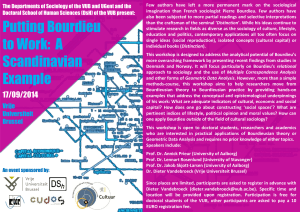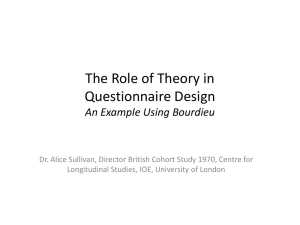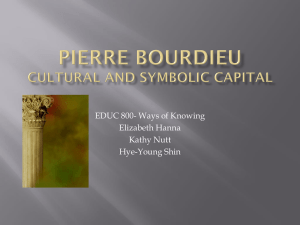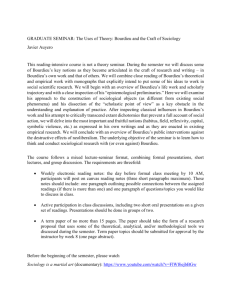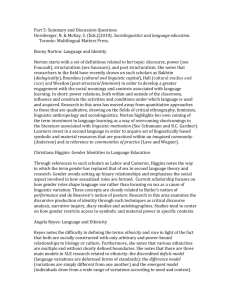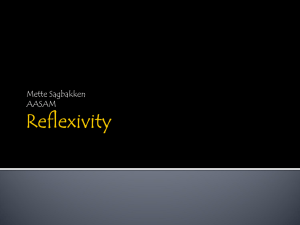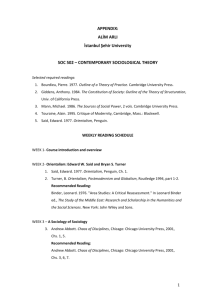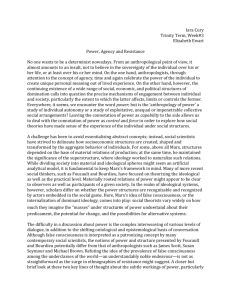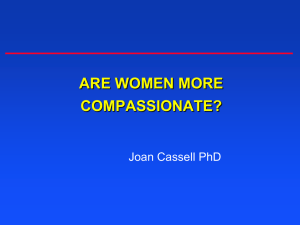How Pierre Bourdieu could have become a cultural policy - Hal-SHS
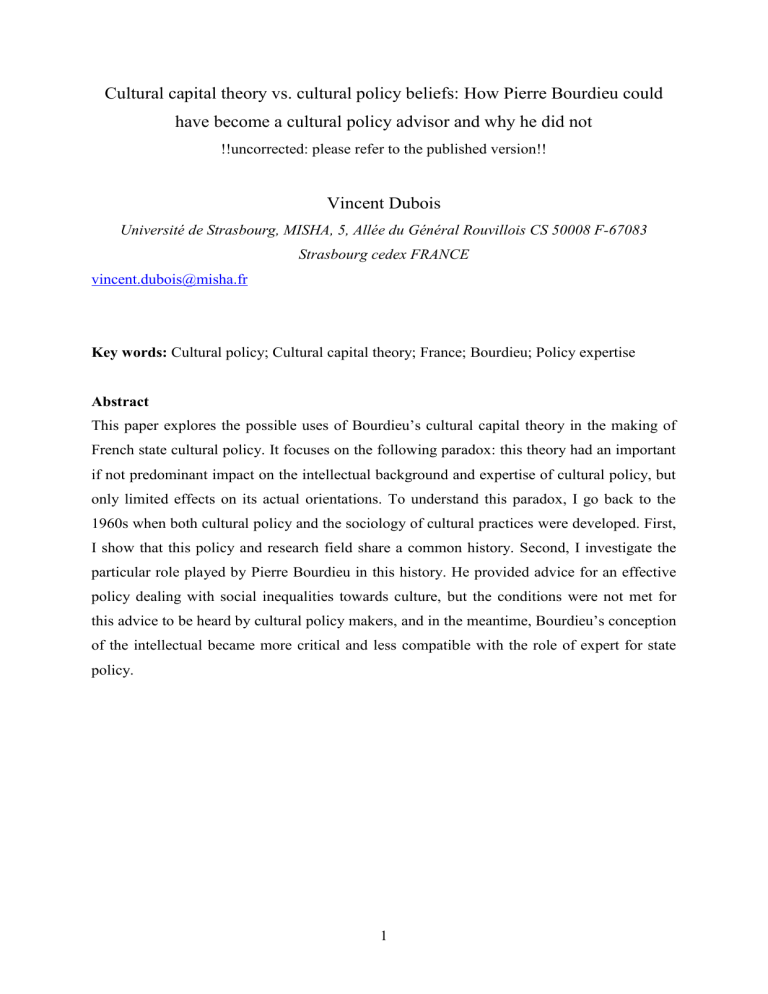
Cultural capital theory vs. cultural policy beliefs: How Pierre Bourdieu could have become a cultural policy advisor and why he did not
!!uncorrected: please refer to the published version!!
Vincent Dubois
Université de Strasbourg, MISHA, 5, Allée du Général Rouvillois CS 50008 F-67083
Strasbourg cedex FRANCE vincent.dubois@misha.fr
Key words: Cultural policy; Cultural capital theory; France; Bourdieu; Policy expertise
Abstract
This paper explores the possible uses of Bourdieu’s cultural capital theory in the making of
French state cultural policy. It focuses on the following paradox: this theory had an important if not predominant impact on the intellectual background and expertise of cultural policy, but only limited effects on its actual orientations. To understand this paradox, I go back to the
1960s when both cultural policy and the sociology of cultural practices were developed. First,
I show that this policy and research field share a common history. Second, I investigate the particular role played by Pierre Bourdieu in this history. He provided advice for an effective policy dealing with social inequalities towards culture, but the conditions were not met for this advice to be heard by cultural policy makers, and in the meantime, Bourdieu’s conception of the intellectual became more critical and less compatible with the role of expert for state policy.
1
1. Introduction
The role Pierre Bourdieu’s work played in the development of the sociology of culture is generally recognized. His theoretical framework was and remains highly influential in the analysis of the production of cultural goods, widely beyond the disciplinary borders of sociology (in cultural and literary studies, art history, and cultural economics for instance), and widely beyond the national borders of the French case on which this theory was first built. We can say the same for his contribution to the analysis of the consumption of cultural goods and the social distribution of taste, as recent research and debates show (see for instance Bennett et al.
, 2009). But Bourdieu also challenged the dichotomy opposing production to consumption with the notion of structural homology at the core of his theory: this notion deploys a relational approach to establish correspondences between positions in the social field dedicated to the arts and culture and positions occupied in the general social space.
All of this is well known, and there are numerous and (sometimes) fascinating applications, explanations or discussions of these aspects of Bourdieu’s work. My purpose in what follows, however, is to apply to Bourdieu’s theory the research program, partly inspired by Bourdieu himself, of a social history of social science (Heilbron et al.
, 2004). I will focus on a specific point: the possible uses of cultural capital theory in the making of French state cultural policy.
This raises important questions concerning the relationship between policymaking and sociological knowledge
1
and, given Bourdieu’s orientation, of the balance between critical sociology and advisory expertise. At the same time, I will argue that a consideration of these questions leads to a better understanding of the social and political background of sociological research. This will shed additional light on the role Bourdieu’s sociology has played in contemporary cultural debates as well as illuminate the impact of these on his own theoretical formulations.
2
1 For a classical essay on this question, see Shils, 1980. For a good overview of the French case, see Bezès et. al.,
2005. See also Chapoulie 2005 on education policy. See also Ahearne, 2007 for an overview with a focus on cultural policy.
2 To some extent, this will also shed light in a more indirect way on other aspects of the social history of French social science, such as the making of cultural capital and distinction theory through the lenses of competition within the scientific field (Bourdieu, 2004), the effects of the social biographies of Pierre Bourdieu (Bourdieu,
2008) and his team members, the relationship between the historical context and the concrete making of a book
(Masson, 2001) or its reception through the objectification of the space of comments (Masson, 2005).
2
By doing so this paper complements existing literature on related topics. The socio-historical analysis proposed here demonstrates how the relationships between various fields
(particularly the bureaucratic and the academic ones) and the correlated social processes (of political legitimization or scientific autonomization) can shape conceptions of cultural issues and policies which are more usually considered from the point of view of the internal contents of ideas and discourses (see for instance Ahearne, 2010). As far as Bourdieu’s personal social and intellectual history is concerned, the exploration of the less familiar role he played in policy expertise complements the description of his well-known activities as a critical public intellectual. Lastly, by focusing on a specific period of time (from the early 1960s to the beginning of the 1970s) it will be possible to offer an in-depth examination of the relationship between institutional settings and personal intellectual strategy and then to fully apply field analysis, which is more difficult in a global overview (Swartz, 2003).
As we will see, there is a strong relationship between the genesis of French cultural policy in the early 1960s and the development of scientific research in the cultural field, including sociological research such as that of Pierre Bourdieu. This relationship was an influential part of the intellectual background that shaped the perspectives of cultural policy makers and, as such, served to legitimize a modern state intervention in cultural affairs. However, Bourdieu’s cultural capital theory occupies a paradoxical place in this history. Bourdieu’s sociology has had (and still has) an important impact on cultural policy debates, but has had only limited effects on the concrete orientations of such policies: it is a point of reference for academic and public debates more than an effective determinant of actual cultural policy practices. It has indirectly inspired some professional practices in cultural institutions such as those of
‘pedagogic action’ or ‘mediation’ aimed at extending a knowledge of the cultural codes required for access to high culture. But French cultural policy makers never used cultural capital theory as the conceptual basis for the cultural democratization policies they have claimed to implement over the last five decades. This contrasts with the strong impact cultural capital theory has had on concrete educational policies and practices together with its intellectual influence on public debates and expertise in this field (Passeron, 2004). To understand this paradox, I will go back to the 1960s when both cultural policy and the sociology of cultural practices were initially developed. First, I will show that this policy and research field share a common history. Second, I will investigate the peculiar role played by
Pierre Bourdieu in this history. While he provided advice for an effective policy dealing with social inequalities in relation to culture, the conditions needed for this advice to be heard by
3
cultural policy makers and to be put into effect were not met. In the meantime, Bourdieu’s conception of the public intellectual became more critical of and, finally, incompatible with the role of expert for state policy. Hence, although he once might have, Bourdieu eventually did not become a cultural policy advisor. This illustrates the paradoxical situation of cultural capital theory in cultural policy: it is often invoked, but to little practical effect.
2. French Cultural Policy and Sociology of Culture: the Socio-historical Conditions of an
Encounter
Despite the famous secular tradition of centralized interventionism of the French state, the existence of an explicit governmental cultural policy was not at all self-evident when the
Ministry for Cultural Affairs was created in 1959. All the previous similar experiments had failed, leaving the bureaucratic structures for the arts more or less as they had been created at the end of the 19 th
century, with few human and financial resources, and no real public policy orientation in this field. The reluctance to develop such an orientation remained strong in the political, bureaucratic and cultural fields where the idea of a cultural policy was viewed as a form of paternalistic governmental propaganda, a frivolous program or a threat to artistic freedom.
The cooperation of social scientists in the making of such a policy was no more obvious. It raised the question of their social role, in the tension between the opposite poles of the policy expert and the public intellectual: ‘governmental cultural expertise’ could be seen as a suspect activity given both the oppositional disposition of French intellectual traditions and the relative novelty of empirical (if not applied) social science research on culture at the time. To understand this unexpected and rather unlikely collaboration I look first at the historical context that informed the initial emergence of a state cultural policy in France. I then discuss those trends and features of the bureaucratic and academic fields in the early 1960s, which shaped the dialogues and relations between social scientists and policy makers around cultural issues.
3
The Ministry for Cultural Affairs was created in July 1959, one year after General de Gaulle came back to power and the subsequent establishment of a new regime supposed to restore
3 These historical notes are based on previous research (see Dubois, 1999: 147-232).
4
the authority of the national government, challenged by the Algerian conflict: the Fifth
Republic. This institutional creation had little to do with a well-prepared policy plan. It was rather a symbol of a specific juncture, when the incorporation of the famous writer André
Malraux within the government signaled support for a particular style of political grandeur.
Malraux was, initially, a Minister without a Ministry. During its first years, the Ministry of
Cultural Affairs was a department with only a loose policy function and few administrative resources. The budget was quite small: no more than what had been allocated to the previous
‘Beaux-Arts’ administrative direction in the Education Department. In 1960 and during the following years, it was the lowest governmental budget, at around 0.4% of the total state budget. There were very few higher civil servants in the Ministry, and even fewer specialized in cultural matters. In the bureaucratic and political fields, the Ministry was regarded less as the perpetuation of a long-lasting and legitimate national tradition than as a fortuitous and bizarre short-time venture doomed to quickly disappear.
A second contextual element should be mentioned. Shortly after the creation of this Ministry a new direction was adopted within the state planning system. Since World War II French planning had first been limited to economic infrastructure and primary needs: reconstruction in the housing sector, transport, energy, agriculture and industrial production. The Fourth
Plan, prepared in 1961-1962, was conceived as the occasion to ‘reintroduce the human’, as planners put it, by adding new policy issues such as education, leisure or social well-being to the planning process. In a period of accelerated social, economic and technological change, planning was no longer limited to the effective organization of production: it became the deliberative and rational preparation for a new society. In such a context, cultural policy could be called on to address ‘civilization issues’ and uncertainties about the future. Such a vision for cultural policy was far removed from the scarce levels of financial support that had previously been allocated to the fine arts in what retrospectively came to be defined as the
‘archaic’ arts policy model, a model that was disconnected from the dynamic tendencies of contemporary artistic innovation and incapable of addressing the cultural issues raised in a changing society. On the other hand André Malraux and his civil servants, despite the fact they did not have much in common with planners in terms of socio-political background, could see the planning agency as a potential ally to increase cultural budgets, gain support from high-ranking officials, and achieve a degree of bureaucratic gravitas while accumulating policy expertise.
5
The cultural planning model and its specialized commissions gave rise to new encounters and exchanges between higher civil servants, members of cultural organizations and experts, including social scientists. These ‘neutral places’, as Bourdieu and Boltanski called them
(Bourdieu, Boltanski, 1976), played a crucial part in the elaboration of official thinking on culture, as planning organizations did, more generally, for the legitimate vision of sociopolitical issues. They also played a key role in the development of state-commissioned research on cultural matters (as they did more generally for social research) and, by doing so, in furthered the progress of French sociology of culture.
To fully understand the social underpinnings of this collaboration, we need briefly to review some of the main characteristics and trends of the French bureaucratic and academic fields in the early 1960s.
4
This was arguably the time when the ‘modernist’ trend was the most dominant in the bureaucratic field. This approach consisted in two combined beliefs (Jobert,
Muller, 1987): first, that French society had to be modernized, and second, that the state was responsible for this necessary modernization. These ideas were shared by the political elite of the ruling parties and by the ‘state nobility’ selected through elite schools (Bourdieu, 1996) which claimed this mission to modernize society. The modernist trend of the policy elite orientated legitimate representations and practices towards a scientistic conception of policy making based on the idea that desirable rational and effective policy could be achieved through the application of scientific knowledge to the development of the appropriate technical tools: social indicators, relevant information systems, decision support and so on.
This policy elite, which mostly came from privileged social backgrounds, was self-assured and fully confident of knowing what was good for people and what people really needed, especially when ‘social needs’ (to quote a typical phrase of this humanist technocracy) had been ‘scientifically’ established. All of this could lead to the explicit call of the policy elite for
‘the knowledge of social scientists’ required to implement this scientistic policy (Pinto, 1977).
This call was, of course, addressed to economists (Dulong, 1997). But it was aimed at sociologists too, especially for matters with ‘a high degree of uncertainty’ (to use a typical technocratic phrase once again) such as cultural issues. This was explicitly expressed during a meeting with sociologists by an important intermediary between social science and the state, the director of the national agency for statistics and economic studies (INSEE):
4 For accounts on this period see Drouard, 1983.
6
‘As an economist and civil servant, I am standing in front of you, sociologists, as a supplicant
[‘quémandeur’]. Nowadays civil servants in charge of economic development planning need the sociologists. They strongly feel the need for sociological research. The success of this new form of managing the state and societies depends on the way the various specialists in the human sciences will collaborate with it.’
5
A number of sociologists, including some who were among the most famous at the time, took part in cultural planning commissions or working groups to prepare the Fourth and Fifth
Plans: Raymond Aron
6
, Michel Crozier, Joffre Dumazedier, Paul-Henry Chombart de Lauwe, and Georges Friedmann for instance; around fifty research contracts were signed with social scientists in the same period. In order to understand why (some) sociologists answered this call we now have to turn to the state of the academic field. In the social and human sciences, the main traditional disciplines still prevailed in French universities: law, philosophy, literature (Bourdieu, 1988). From an academic point of view, the Durkheimian institutional and promotional enterprise of sociology – if not its intellectual project – had misfired
(Heilbron, 1985). In the early 1960s this discipline was still a young and dominated one: there were only a few sociologists in university departments, and the bachelor degree in sociology had just been created in 1958 (Chapoulie et al., 2005; Drouard, 1982, 1989; Montlibert,
1982). Academic sociology was quite weak and a substantial part of it remained in the scholastic tradition of theoretical and speculative approaches. The ‘second founding’
(Chapoulie, 1991) of French sociology required its position and its scientificity to be asserted in opposition to the domination of philosophy and literary studies, and also in opposition to the declining old school of sociology.
The promotion of empirical research was a central issue in this struggle. The reference to the
American ( i.e.
Lazarsfeldian) model of survey research was used to discredit the speculative tradition as archaic and non-scientific and to prove the modernity, the scientificity and the social usefulness of sociology faced with the dominant disciplines of the human sciences. But empirical research requires funding, whereas direct public support for social science research and private contract social research was and remained scarce. The call of the policy elite to sociologists was thus heard and interpreted in this context: state commissioned research was a means to promote a renewed sociology which, having gained social and scientific legitimacy thanks to support outside academia, could subsequently assert its position in the academic
5 Claude Gruson, ‘Planification économique et recherches sociologiques’, Revue Française de Sociologie , 5,
1964, p. 435. Account of a meeting held on March 14th 1964. (My translation).
6 In fact Aron was appointed as a member but it seems that he did not actually participate.
7
field. As Michael Pollak has explained, temporary acceptance of heteronomy through the compromises of more or less applied research proved necessary to gain autonomy in the academic field (Pollak, 1976). This interpretation applies to the renewal of French sociology in general: it applies even better to the involvement of sociologists in collaboration with state agencies for research on arts and cultural issues more specifically. These were undoubtedly good domains to demonstrate the overall vocation of sociological research and strategic topics to address, in competition with the literary and artistic disciplines, which viewed the arts and culture in a traditional aesthetic perspective. Culture was also a relevant field to combine the
‘critical’ and ‘practical’ functions of sociologists as public intellectuals by fusing the production of relevant (and often statistical) facts with assertions implicitly or explicitly including more normative statements on values and social organization.
Based on these auspicious conditions, the collaboration of policy makers and social scientists was made concretely possible by multi-positioned agents who, crossing different fields, advocated a science-based cultural policy. Here we can think of Joffre Dumazedier, who developed sociology of leisure while being involved in one of the most important cultural training organizations created after World War II (Peuple et Culture) and who was strongly involved in cultural planning. We can also think of Augustin Girard who organized in
November 1964 a conference entitled ‘Figures for culture’ (‘Des chiffres pour la culture’) where 120 economists, sociologists and civil servants discussed the making of a social science policy for cultural affairs.
7 This conference passed a resolution stating that ‘a rational, effective and fair cultural development policy in the broad sense of the term must not depend on subjective choices based on generosity or taste but has to rely on the objective knowledge of cultural action, as well as of the conditions of creation, that is the first source of this action’ and went on to assert ‘the necessity of a methodical and continuous scientific research policy which is the only way to enlighten the planners in orientating cultural investments’.
8
After the
Fourth Plan did not fully fulfill its promises for a scientific cultural policy, such statements were made in order to prepare the Fifth Plan and to obtain the official creation of the research unit created and lead by Girard in the Ministry for Cultural Affairs.
There is no doubt that in this era of scientistic mood, some of the representatives of the planning agency and of the Ministry for Cultural Affairs were sincerely convinced that social
7 On Dumazedier and Girard, see Dubois, Georgakakis, 1993.
8 Account in ‘Le colloque de Bourges’, Expansion de la recherche scientifique, 22, 1965, p. 7-8.
8
science research could provide the basis for a rational cultural policy. But the procedural decisionist model according to which the experts produce the facts needed to shed light on political decisions is far too simple. Leaving to one side the possible normative role of sociologists as advisory experts, social science was used as a mode of legitimation more than as an instrument for the development of effective mechanisms for putting policies into effect and assessing their outcomes. This legitimation strategy was explicit in a context of launching a new modernized cultural policy program. The modernist reference to the necessity of a social science approach was a means of removing the definition of the new policy from the traditional divides of the cultural field (Dubois, 1999: 193-198). Moreover, the recourse to scientific expertise was part of an institutional enterprise to promote culture as a legitimate policy domain. ‘Cultural policy must no longer be commanded by aesthetic and moral motives but must be conceived on the basis of objective data and be scientifically based on social needs’, as the head of the Minister of Culture’s personal staff argued.
9
The main point was less about the particular contributions that social science findings might make to actual policy processes than the fact that the Ministry could invoke a discourse of expertise in producing support for its increasing claims on the public purse. This legitimizing rhetoric
(Gusfield, 1981: 83-109) could be all the more effective when it was based on empirical, and preferably quantitative data, especially if the point was to convince the technocrats at the
Ministry of Finance that cultural policy deserved more budgetary resources.
3. The Measurement of Social Inequality in Relation to Culture and Bourdieu’s Cultural
Capital Theory
Questions concerning the relations between social inequality and culture defined the crossroads for these various strategies and preoccupations. “Cultural inequality” was constructed as a central political issue in the legitimation strategies of the Ministry of Culture, which argued on this basis for its social necessity. The ‘democratization of culture’ was the reason given for the creation of a department dedicated to culture. It was necessary to prove how considerable cultural inequalities were in order to show how important this policy goal was. Providing figures establishing the high proportion of people who never go to the theatre or to museums could then be used as an argument in favor of the new Ministry. As Augustin
Girard put it: ‘We were stronger in the discussion with the backers if we could prove the
9 ‘Le colloque de Bourges’, art. cit.
9
existence of needs […] in an objective argumentation. When with our firsts surveys we could show that 90% of French people had never attended a concert in their whole life, 98% an opera or 75% a theatre play, we were showing the extent of the effort required to achieve the equal access claimed by the Republic’s principles and the state’s voluntarist planning’.
10
In the meantime, the use of quantitative data on cultural practices met the technocrats’ expectations for an evidence-based policy and the sociologists’ claim for scientific recognition. More generally, sociologists could easily translate these policy concerns into research questions.
Bourdieu participated in these exchanges between policy and science by conducting commissioned research, taking part in meetings, and by presenting results from his surveys and policy papers to government officials. But his orientations quickly drove him away from a role as policy advisor as his sociology became a major reference for cultural research even in the bureaucratic field.
11
His research on the publics of European museums published in The
Love of Art (Bourdieu, Darbel, 1990) is certainly the best example of this dual position. The book was first published in French in 1966. It was conceived in continuity with Bourdieu’s previous book, published two years earlier,with Jean-Claude Passeron on the role of cultural inheritance in the reproduction of social inequalities in the higher education system
(Bourdieu, Passeron, 1979). But The Inheritors was above all the first step towards the sociological theory of the education system presented in Bourdieu and Passeron’s 1970 book on social reproduction (Bourdieu, Passeron, 1979). The Love of Art , as its title indicates, focused on the social uses of art, anticipating Bourdieu’s later demonstration in Distinction , first published in 1979 (Bourdieu, 1984), of the implication of art practices in the social process of class formation Whereas Bourdieu and Passeron spoke of ‘inherited culture’ or
‘cultural privileges’ in
The Inheritors , the notion of artistic or cultural capital was used in The
Love of Art as a first approximate formulation.
I do not intend to discuss here the sociological contents of the book; I will rather focus on its relationship with cultural policy making agencies and processes. The survey was commissioned by the Ministry for Cultural Affairs and the planning agency (which is not mentioned in the book). The research question (what determines the act of going to museums
10 1993 interview published in Dubois, Georgakakis, 1993: 69.
11 For a useful presentation of Bourdieu’s cultural policy thinking in complement to this paper see Ahearne,
2004: 17-26; 41-77 and Ahearne, 2010: 105-121.
10
or not?) and the method used to explore it (a quantitative survey based on a questionnaire) set the blueprint for future socio-statistical works on cultural attitudes including the surveys of the French population’s cultural practices conducted by the Ministry of Culture’s research unit in 1973, 1981, 1989, 1997 and 2008.
12
More broadly, the analysis contributed to reformulating the question of cultural inequalities in scientific and policy debates in a more complex way than the unequal access to a supposedly universal high culture: it showed the
‘social arbitrariness’ underpinning this so-called ‘universality’ and explained the ‘social functions’ that this unequal access could perform. But it was not only a statistical and theoretical contribution. It also addressed policy questions, sometimes in an indirect or implicit way in the book, but very explicitly in other presentations. Before the book was published, the results had indeed been presented in a policy paper (Bourdieu, 1964), at several meetings with planners and agents of the Ministry including the 1964 conference ‘Figures for culture’, and at a conference with statisticians and economists in 1965 (Bourdieu, 1966).
Bourdieu had also presented his findings in a paper he presented at the Avignon meeting bringing together theatre directors and cultural policy actors,
13
and a paper on the democratization of education written after May 68 also indirectly refers to the book
(Bourdieu, 1968).
The four main cultural policy lessons which could be derived from Bourdieu’s were as follows.
14
1. Since the act of visiting museums (and by extension any cultural institution, and by extension again, access to culture) is determined by previously acquired dispositions that render such a visit thinkable or not, an efficient democratization policy should target these social dispositions.
2. Since the ability to understand and appreciate art is not innate but based on codes that enable understanding and appreciation, a democratization policy should aim at providing these codes to the social groups who have not acquired them.
12 See: http://www.pratiquesculturelles.culture.gouv.fr/index.php
. This periodic survey is the main statistical reference in the field in France. Sociologists and cultural organisations often use not only its data but also part of its questionnaire for other surveys in order to establish comparisons at national level or with other practices.
13 ‘L’inégalité devant l’école comme principe de l’inégalité devant la culture’, paper distributed during the
‘Deuxièmes rencontres d’Avignon’, 1965. Full published version: Bourdieu, 1966 (English translation in
Ahearne, 2002: 62-69).
14 Even though they were not presented as such in the book these practical conclusions logically followed from its reading. Bourdieu translated them into explicit advice in his presentations and policy papers.
11
3. Reciprocally, since the meaning of art is not necessarily given in the contents of works of art, pedagogic support is required through explanatory panels or guides in the cultural venues themselves.
4. Since the sacralization of culture leaves out ‘profane’ agents, a cultural democratization policy should de-sacralize and humanize cultural institutions in order not to intimidate the visitors and to make them feel at ease.
Far from being actively embraced, most of these policy prescriptions were not heard at the time. They were not compatible with the beliefs of the cultural policy entrepreneurs of the
Ministry of Culture or of the planning agency; and they were also in contradiction with the dominant professional ideologies of cultural managers and with the leading cultural activist organizations such as Peuple et Culture.
15
These beliefs and ideologies mainly consisted in (a) an anti-pedagogical conception of the access to culture based (b) on the idea of the direct exposure of people to cultural goods as a necessary and sufficient condition for cultural democratization and, accordingly, on (c) a quasi-religious vision of culture. It is quite easy to see how Bourdieu’s sociology went against these three features of the dominant representation of culture at the time. Indeed, it did so intentionally and explicitly in three main ways.
(a) Bourdieu’s first piece of advice consisted in thinking of a cultural democratization program as part of a policy aiming at reducing social inequalities in general, in which education, as the main mode of access to social positions, should be the foremost concern. On the one hand, Bourdieu showed how crucial so-called ‘free culture’ – that is, culture acquired outside the school – could be for academic achievement and thus on the ability to meet school expectations (Bourdieu, Passeron, 1979).
16
On the other hand, school was accorded a key role in Bourdieu’s conception of cultural democratization as giving people ‘the means to possess culture’ instead of (naively or not) pretending to ‘give them culture’ without putting into place the means and mechanisms that could alone have any real impact on the social distribution of cultural competencies. But setting culture in the frame of an education policy was the exact opposite of what the newly created Ministry for Cultural Affairs intended (Dubois, 1999: 169-
15 On the opposite conceptions of cultural policy of Malraux and Bourdieu see Ahearne, 2010: 86-121.
16 The second proposition of Bourdieu’s 1968 policy paper consists in giving the chance from nursery school onwards to every child to have the cultural experience (visit to museums, to monuments, to the theatre, historic travels, listening to music, etc.) that children from cultivated backgrounds have in their own families. Bourdieu,
1968: 69-70 (English translation in Ahearne, 2002, p. 62-69).
12
171; Urfalino, 1996: 31-99). This institution was precisely created by separating cultural affairs from the Education department. To lay claim to its legitimacy and its specific policy area, Malraux and his civil servants explicitly defined it in a distinct if not an opposite orientation, and proposed an anti-pedagogical model for state cultural policy.
This mainly consisted in a cultural ‘supply policy’ stating that new institutions would attract a renewed public: the Ministry and the planning agency were thinking and speaking in terms of
‘cultural action’ and ‘cultural equipment’ as necessary and sufficient means for achieving cultural democratization. In The Love of Art Pierre Bourdieu referred to this policy ironically as ‘direct cultural action’ and argued that it was bound to fail.
‘[…] We can only doubt the effectiveness of all the techniques of direct cultural action, from the
Houses of Culture to the enterprises of popular education, which, as long as inequalities persist in relation to school (the only thing capable to creating the cultivated attitude), do nothing but palliate (in the precise sense of conceal) those cultural inequalities which they cannot substantially and above all durably reduce. There is no shortcut to the path which leads to the works of culture, and artificially contrived and directly provoked encounters cannot have any long-term effects’.
17
On the contrary, he urged the need for strong links to be established between schools and cultural policy:
‘Everything must be done to bridge the gap between the marginal institutions of adult education or cultural diffusion (Houses of Culture, cultural animation, etc.), and the education system [institution scolaire]. The anti-educational ideology to be found among most of those responsible for running these organizations can only be combated if their mode of recruitment is profoundly changed and if teachers are closely associated at all levels to these enterprises.’ 18
(b) ‘Direct cultural action’ relies on the ‘charismatic ideology of art’ firmly denounced in
The
Love of Art
. This ‘charismatic ideology’ states that the aesthetic contents of art works are selfsufficient: facing a masterpiece magically and universally provokes the emotion required for an aesthetic response. Placing any intermediary between people and art is accordingly useless and even counter-productive since pedagogy is said to destroy the emotional trigger that aesthetic response requires. The very first pages of The Love of Art are dedicated to this
‘mystic representation of aesthetic experience’ and, even through he is never mentioned by name, these critical remarks cannot help but be read as criticisms aimed at André Malraux’s conception of art. As an implementation of the ‘charismatic ideology’, the Houses of Culture
17 Bourdieu, 1966, translated by Ahearne, 2002: 65.
18 Proposal 15, Bourdieu, 1968: 48 (2008 English version).
13
are on the other hand criticized in a direct and quite harsh way. These institutions symbolizing the new cultural policy program (Urfalino, 1996: 161-205) were conceived as a means to bring high culture directly to people thanks to the talent of the ‘creators’ who were managing them, bypassing traditional cultural intermediaries such as school teachers, local arts societies or popular education organizations.
(c) Finally, the religious metaphor used by Bourdieu to challenge the ‘sacralization of culture’ could be heard as the critical echo of the lexicon of contemporary cultural policy discourse.
Malraux and cultural policy makers used this metaphor in a quite literal sense, speaking of culture as the substitute for religion that would preserve a sense of community and of spiritual values in the midst of a secularized materialist society. Malraux invoked the ‘communion’ of the people in the admiration of collectively celebrated masterpieces as the goal that was to be reached thanks to cultural policy. The Houses of Culture were described as the ‘cathedrals’ of modern times where this communion should take place. This vocabulary must not be reduced to a commonplace rhetoric: it expressed the more or less theorized representation of culture informing cultural policy. In this representation, ‘sacralization’ was not to be avoided but was rather a goal to be achieved.
We can now understand better why, even though they could have been relevant for concrete cultural policy programs, Bourdieu’s analyses could not have been received as such by cultural policy makers. His research certainly provided the ‘hard facts’ and quantitative data on which ‘cultural planning’ was supposed to be based. Implicitly or explicitly it also provided policy advice. But for this advice to be followed it would have needed to fit with the general intellectual and practical frameworks that cultural policy makers were building. This was not so for two reasons.
First, such advice should have been, if not ‘optimistic’, at least ‘positive’, whereas Bourdieu’s position was viewed as a negative demonstration of obstacles leading, ultimately, to a refusal of any kind of ‘cultural action’. The contrast with Dumazedier’s sociology of leisure in which a so-called pragmatic approach proposed ‘solutions’ that might be aligned with an optimistic orientation is very sharp. Dumazedier’s position could be regarded as sociologically naïve
(and it was described as such by Bourdieu) but it was the kind of scientific discourse ‘men of action’ like to hear. Policy makers needed arguments based on recognized scientific knowledge to prove that their action was both necessary and rational, and left aside those
14
which could weaken the faith in their ‘mission’, a mission which had still to be legitimized.
Cultural policy makers who supported collaboration with sociologists, as did members of the
Ministry’s research unit, saw in the so-called ‘pessimistic’ analysis of Bourdieu a threat to this collaboration and probably restricted its distribution inside the administration for this reason.
Secondly, advice had to comply with basic policy axioms if it were to have a chance of being put into effect. If the reduction of social inequalities regarding culture could be widely considered as a legitimate policy goal (and one Bourdieu undoubtedly shared), the most basic axiom was that a separate specifically cultural policy program was necessary to achieve this goal. Since Bourdieu’s conclusions pointed towards the reduction of cultural inequalities as being possible only as part of an education policy program, they undermined the whole institutional and policy enterprise of the Ministry for Cultural Affairs. It was, of course, not only a matter of ‘cognitive dissonance’, as social psychologists of decision making would say.
A specifically cultural policy focus fitted with the professional habits and interests of the managers of cultural institutions since it would possibly provide more support for their organizations and open new career opportunities. It also squared with the interests of the new cultural activists who wanted to turn such intermediary cultural functions as ‘cultural project manager’ and ‘cultural event organizer’ into professional occupations. Bourdieu’s sociological warnings challenged these beliefs and corresponding positions. At a time when cultural policy promoters viewed themselves as pioneers, they could neglect Bourdieu’s warnings as the expression of the ‘contemptuous skepticism’
19
of a theorist while validating their own positions as reflecting their involvement in concrete experience. They could do so with all the more reason when Bourdieu later expressed severe judgments about cultural policy makers or cultural ‘animateurs’ who were either believing in false ‘common sense’ ideas or pursuing their own professional interests in the name of a generous cultural mission.
20
As a result, despite the fact that Bourdieu’s cultural capital theory quickly became a key reference point for the study of cultural practices commissioned by cultural policy institutions and in the scientific and policy debates on ‘cultural inequalities’, his sociological conclusions challenged the beliefs and positions of cultural policy makers to such an extent that they were unable to translate them into concrete orientations.
19 Jacques Charpentreau, Pour une politique culturelle , [ Towards a cultural policy ], Editions Ouvrières, Paris,
1967, p. 57. Charpentreau, a teacher, poet and writer, wrote several books giving intellectual justifications to cultural action.
20 Bourdieu, 1979: see for instance p. 104.
15
4. The Mutations of the Late 1960s
As we have just seen, there were originally tensions which prevented Pierre Bourdieu from becoming fully involved in a cultural policy advisor role: his conception of a cultural policy was to a large extent at odds with the one promoted by the Ministry of Cultural Affairs and being a commissioned expert proved difficult to reconcile with the claim for extended scientific autonomy, not to mention the critical function of the public intellectual. These tensions, if not absolute contradictions, were temporarily softened for various reasons during the short period of the mid-1960s. A temporary compromise was found when the official cultural policy makers needed the involvement of a young talented sociologist such as Pierre
Bourdieu and when the latter needed government funding and support to develop his sociological enterprise. This compromise had its limits as the contents of The Love of Art show. Some of the statements made in the book can indeed lead us to think that Bourdieu had already decided not to go on with further collaboration in cultural policy making as defined by the planning agency and the Ministry for Cultural Affairs. Such a (limited) compromise was not possible after the changes of the late 1960s.
The protests that unfolded in May 1968 and during the following years had various consequences for the conception and standing of cultural policy. First, they challenged the
‘paternalistic’ and ‘bourgeois’ model of cultural policy. Malraux left his Ministry in 1969 when General de Gaulle left power and he never came back, opening a decade of aggiornamento for state cultural policy. If Bourdieu had criticized Malraux’s model, he was at the same time strongly critical about what he described as the populist dream of a spontaneous culture as envisioned by the leftists. He refused to come out in favor of either party since both of these two opposite orientations were, according to his analysis, based on illusions. He thus remained faithful to his criticisms of, if not the pointlessness, the insufficiency of a specifically cultural policy, which, as shown in his 1968 policy paper, he continued to define as part of a sociologically realistic education policy. This, though, was not on the agenda of the new cultural policy makers who preferred to go along with Dumazedier’s more open notion of ‘cultural development’ or to think in terms of ‘everyday culture’ in a manner partly inspired by Michel de Certeau.
21
21 On de Certeau’s work on cultural policy, see Ahearne, 2004: 78-110; 2010: 175-193.
16
Secondly, it was the whole Gaullist regime and style of government that had been challenged by the events of 1968. In this general protest, the technocratic dream of an effective and democratic (cultural) policy thanks to (social) science was over, and sociologists who cooperated with official bodies could be denounced as social engineers providing information and tools to support ‘bourgeois state domination’. This, of course, was not enough to put an end to the close cooperation between state agencies and social scientists, which continued after 1968. However, it was no longer possible to disregard the political implications of such collaboration, including even the space given to some radical leftists inspired by Foucault or
Althusser in state-commissioned social research.
These changes appear clearly if we look once more at cultural planning. The Sixth Plan for the period 1971-1975 was prepared in 1970-1971. More than just a venue for the debate and development of practical cultural policies, the new Commission for Cultural Affairs was viewed by several of its members, including its chairman the poet Pierre Emmanuel, as a place for global social debate. It was used as an official forum by public intellectuals to express their critical views, and was consequently criticized as an anti-governmental body, committed to negative and pessimistic critique, by the higher civil servants in the Ministry of
Culture. In the end the Commission collectively resigned and so did the newly created
“council for cultural development”. It is easy to see that such an atmosphere was totally different from the two previous cultural plans, which had an impact on the involvement of sociologists who also defined themselves as public intellectuals.
Quite surprisingly, given his previous statements on cultural policy, Pierre Bourdieu was invited in 1970 to present a paper to the working group of the Commission expected to define
‘long-term objectives’ (Ahearne, 2010: 116-121).
22
This time, instead of a policy paper, he gave a provocative lesson in critical sociology aiming at unveiling the social underpinnings of the attitudes of the unwitting cultural policy makers. Bourdieu started his presentation with a critique of two representations of what he called ‘cultural diffusion’: the populist one according to which the culture of the lower classes is seen as equal in value to the dominant culture; and the legitimist one according to which dominant culture must be diffused among those classes ‘who are dispossessed of it’. He presented these two representations as opposing
22 Exposé de M. Pierre Bourdieu, Commission des Affaires culturelles, VIe Plan, groupe de travail Long terme, sous-groupe Finalités, 13 mai 1970, PLAN/LT/CR 7, 35 p.
17
but complementary forms of sociological naivety, arguing that both positions ignored the respects in which cultural forms are defined by ‘the social conditions of their production’ and by the ‘structural relation’ between them (p. 2). Having set the tone, he turned to the sociology of the intellectuals and, more precisely, to the relationships between intellectuals and ‘various fractions of the ruling classes’ (p. 6), explaining how artists and intellectuals as
“dominated-dominant” social agents could serve the social interests of the dominant classes even when they seemed to criticize them. In doing so he elaborated on the respects in which so-called ‘disinterested’ art and the critique of the ‘bourgeois’ by artists could come to form a part of bourgeois strategies of social distinction.
Instead of giving his point of view on an effective cultural policy orientation, he defined the debate on cultural policy in terms of a struggle between different fractions of the dominant class to impose the legitimate form of socio-cultural domination. In so doing, he implicitly referred each working group member to his position in these various fractions (journalist, civil servant, policy expert, cultural manager, public intellectual, etc .), turning the group into an object of sociological observation and the audition of an ‘expert’ into a sociological experiment. His point was ultimately that what is at stake in cultural policy debates is not the relationship between the people and culture, but relationships inside the dominant classes and between their intellectual fractions and the state. It was a clear way not only of refusing to be employed as a cultural policy expert but also of refusing to legitimize policy makers by serving as the critical intellectual alibi for exhibiting their open-mindedness.
This double and final refusal undoubtedly marked a shift from the cooperative attitude
Bourdieu had shown in 1964-1965 during the making of The Love of Art.
But we have to nuance the importance of this change, bearing in mind the doubts he expressed from the start about cultural policy as defined by the Ministry for Cultural Affairs. Moreover, it would be far too simple to interpret this change purely in an individual perspective as a traditional biographer would do, looking for changes and continuities in a person’s attitude without setting these in the broader context of the various and changing systems of social relationships that person is involved in. Cultural policy making and the cooperation of sociologists with state agencies and professional sociology in 1970 did not have the same social meaning they had in 1964, not to mention the social position of Bourdieu himself who, in the meantime, had left his position as a lecturer at the University of Lille to become a research professor and
18
head of a research centre in the prestigious Ecole Pratique des Hautes Etudes in Paris. He had also, by then, published five influential books, including Distinction .
5. Conclusion
Thirteen years after The Love of Art, Distinction had a huge impact on the sociology of cultural tastes and practices and indirectly affected public debates on culture and cultural policy. French governmental cultural policy also changed over the same period. But the intellectual and institutional framework that was set at the beginning of the 1960s has had long-term effects on the actual orientations of cultural policies, and continues to do so. The tendency to give priority to institutional cultural supply and the separation of cultural policies from the education system, for instance, are still the two main characteristics of French cultural policies. Bourdieu’s theory of cultural capital as the main factor accounting for social inequalities in access to culture, and the corollary that education is the most effective means for reducing such inequalities, have had only limited impact on actual policy orientations, for the reasons we have shown in this paper.
It could be argued that cultural capital theory is untranslatable into any concrete action because of its contents. We have seen that this has not been the case so far as the relations between cultural capital theory and French education policy are concerned. It should be noted here that the left-wing government asked Bourdieu to write two education policy papers in the
1980s.
23
Even when his direct recommendations have not been followed, his academic writings have had an indirect but nevertheless huge impact. The zoning program consisting in giving additional means and support to schools in deprived areas that was launched at the beginning of the 1980s (Zones d’éducation prioritaires) is a good example. In addition to the models provided by US and UK experiments, this program is explicitly inspired by the
‘rational pedagogy’ Bourdieu and Passeron called for to reduce the ‘cultural handicap’ that pupils from lower social backgrounds experienced due to their lack of cultural capital
(Passeron, 2004). We could also think of the influence Bourdieu’s sociology has had on the way teachers view their role, the functions of the school system and their pedagogic methods.
It is, then, not the contents of cultural capital theory that determine its possible concrete uses,
23 Collège de France, Propositions pour l’enseignement de l’avenir élaborées à la demande de Monsieur le
Président de la République par les professeurs du Collège de France , 1985; Pierre Bourdieu, François Gros,
Principes pour une réflexion sur les contenus de l'enseignement , 1989.
19
but the social conditions of its reception. For various reasons, cultural policy agents have proved reluctant to adopt a ‘disenchanting’ theory which challenges their ‘enchanted vision of the social world’, to put it in Bourdieu’s words, during a period when this theory has been more actively embraced as a reflexive tool in the educational field.
It is in this sense that Bourdieu’s sociology might appropriately be defined as the bad conscience of French cultural policy. This status could be seen as a failure, but in the end, it fits quite well with the conception of the social functions of sociology that Bourdieu has progressively developed according to which sociology ‘must choose […] between putting its rational instruments of knowledge at the service of an increasingly rational domination, or rationally analyzing domination and especially the contribution that rational knowledge can make to domination’ (Bourdieu, 1998, 91). Bourdieu obviously chose this second option. This was clear since his very first researches on domination in colonial Algeria. His reluctance to serve as a cultural policy advisor when policy makers used sociology as a legitimization resource more than as a base for a rational democratization policy illustrates the history of this choice.
Acknowledgements
A previous draft of this paper was presented at the 2010 SCUD workshop in Milton Keynes
(UK). I thank Tony Benett and Elisabeth Silva for organizing this meeting, editing this issue and helping me in the process of publishing this paper. Thanks also to Jeremy Ahearne, Jean-
Yves Bart and Geneviève Gentil for their kind help.
References
Ahearne, J. (Ed.), 2002. French Cultural Policy Debates. A Reader. Routledge, London.
Ahearne, J., 2004. Between Cultural Policy and Theory: The Cultural Policy Thinking of
Pierre Bourdieu, Michel de Certeau and Régis Debray. Centre for cultural policy studies,
University of Warwick, research paper no. 7, Coventry.
Ahearne, J., 2007. Public intellectuals and cultural policy in France. In Ahearne J. and
Bennett O. (Eds.), Intellectuals and Cultural Policy. Routledge, London, pp. 209-225.
Ahearne, J., 2010. Intellectuals, Culture and Public Policy in France. Approaches from the
Left. Liverpool University Press, Liverpool.
20
Bennett, T., Savage, M., Silva, E., Warde, A., Gayo-Cal, M., Wright, D., 2009. Culture,
Class, Distinction. Routledge, Abington.
Bezes, P., Chauvière, M., Chevallier, J., Montricher, N., Ocqueteau, F., (Eds.), 2005. L’État à l’Epreuve des Sciences Sociales. La Fonction Recherche dans les Administrations sous la Ve
République. La Découverte, Paris.
Bourdieu, P., 1964. Le Musée et son Public. EHESS, Centre de Sociologie Eurpopéenne,
Paris.
Bourdieu, P., 1966. La transmission de l’héritage culturel. In: Darras, Le Partage des
Bénéfices. Expansion et inégalités en France, éditions de Minuit, Paris, pp. 383-420.
Bourdieu, P., 1968. Quelques indications pour une politique de démocratisation. Reproduced in Bourdieu P., 2008. Public Interventions: Social Science and Political Action. Verso,
London, pp. 46-48.
Bourdieu, P., 1984 [1979]. Distinction: a Social Critique of the Judgement of Taste.
Routledge, London.
Bourdieu, P., 1988 [1984]. Homo Academicus. Stanford University Press, Stanford.
Bourdieu, P., 1996 [1989]. The State Nobility. Elite Schools in the Field of Power. Stanford
University Press, Stanford.
Bourdieu, P., 1998 [1994]. Practical Reason. Stanford University Press, Stanford.
Bourdieu, P., 2004 [2001]. Science of Science and Reflexivity. University of Chicago Press,
Chicago.
Bourdieu, P., 2008 [2004]. Sketch for a Self-Analysis, University of Chicago Press, Chicago.
Bourdieu, P., Boltanski, L., 1976. La production de l’idéologie dominante. Actes de la
Recherche en Sciences Sociales 2 (2-3), 3-73.
Bourdieu, P., Darbel, A. 1990 [1966]. The Love of Art: European Art Museums and their
Public. Stanford University Press, Stanford.
Bourdieu, P., Passeron, J.C., 1979 [1964]. The Inheritors. French Students and Their Relation to Culture. University of Chicago Press, Chicago.
Bourdieu, P., Passeron, J.C., 1990 [1970]. Reproduction in Education, Society and Culture.
Sage, London and Newbury Park.
Chapoulie, J.M., 1991. La seconde fondation de la sociologie française, les États-Unis et la classe ouvrière. Revue Française de Sociologie 32 (3), 321-364.
Chapoulie, J.M., 2006. Les nouveaux spécialistes des sciences sociales comme ‘experts’ de la politique scolaire en France 1945-1962. Genèses 64 (3), 124-145.
Chapoulie, J.M, Kourchid, O., Robert, J.L., Sohn, A.M., (Eds.), 2005. Sociologues et
Sociologies. La France des Années 1960. L’Harmattan, Paris.
Drouard, A., 1982. Réflexions sur une chronologie: le développement des sciences sociales en
France de 1945 à la fin des années soixante. Revue Française de Sociologie 23 (1), 55-85.
Drouard, A., (Ed.), 1983. Le Développement des Sciences Sociales en France au Tournant des
Années Soixante. Editions du Centre National de la Recherche Scientifique, Paris.
Drouard, A., 1989. The development of sociology in France after 1945. In: Genov, N., (Ed.),
National Traditions in Sociology. Sage, Beverly Hills, pp. 66-80.
21
Dubois, V., 1999. La Politique Culturelle. Genèse d’une Catégorie d’Intervention Publique.
Belin, Paris.
Dubois, V., Georgakakis D., Sciences sociales et action culturelle. Entretiens avec J.
Dumazedier and A. Girard. Politix, 24, 57-77.
Dulong, D., 1997, ‘Moderniser’ la République. Aux Origines de la Ve République.
L’Harmattan, Paris.
Gusfield, J.R., 1981. The Culture of Public Problems: Drinking, Driving and the Symbolic
Order. Chicago University Press, Chicago.
Heilbron, J., 1985. Les métamorphoses du durkheimisme, 1920-1940. Revue Française de
Sociologie 26 (2), 203-239.
Heilbron, J., Lenoir, R., Sapiro G., (Eds), 2004. Pour une Histoire des Sciences Sociales.
Hommage à Pierre Bourdieu. Fayard, Paris.
Jobert, B., Muller, P., 1987. L’Etat en Action. Presses Universitaires de France, Paris.
Masson, P., 2001. La fabrication des Héritiers. Revue Française de Sociologie 42 (3), 477-
507.
Masson, P., 2005. Premières réceptions et diffusions des Héritiers (1964-1973). Revue d’Histoire des Sciences Humaines, 13 (2), 69-98.
Montlibert (de), C., 1982. La professionnalisation de la sociologie et ses limites. Revue
Française de Sociologie 23 (1), 37-53.
Passeron, J.-C., 2004. Le sociologue en politique et vice versa : enquêtes sociologiques et réformes pédagogiques dans les années 1960.
In Bouveresse, J., Roche, D., (Eds.), La Liberté par la Connaissance. Pierre Bourdieu (1930-2002). Odile Jacob, Paris, pp. 15-104.
Pinto, D., 1977. Sociology as a Cultural Phenomenon in France and Italy (1950-1972).
Harvard University Press. Cambridge.
Pollak, M., 1976. La planification des sciences sociales. Actes de la Recherche en Sciences
Sociales 2 (2-3), 105-121.
Shils, E., 1980. The Calling of Sociology and Other Essays on the Pursuit of Learning. The
University of Chicago Press, Chicago.
Swartz, D.L., 2003. From critical sociology to public intellectual: Pierre Bourdieu and politics. Theory and Society 32(5-6), 791-823.
Urfalino, P., 1996. L’Invention de la Politique Culturelle. La Documentation française, Paris.
Vincent Dubois is professor at the University of Strasbourg, and a member of the Institut
Universitaire de France. He belongs to the Centre for European Political Sociology (GSPE-
PRISME, UMR 7012) and is associate member of the Centre de sociologie européenne
(EHESS, Paris). His interests are in cultural policy and welfare administration. He recently published The Bureaucrat and the Poor: Encounters in French Welfare Offices , Aldershot,
22
Ashgate, 2010 and Lowbrow culture and French cultural policy, International Journal of
Cultural Policy , 17 (4), 2011.
23
